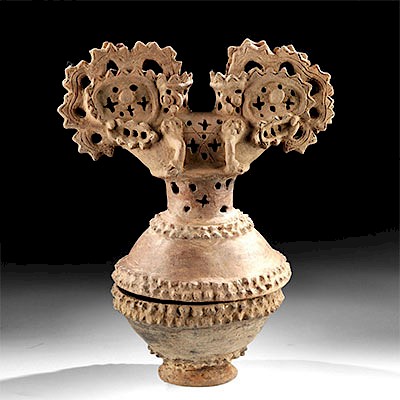Egyptian Wood Coffin Upper Lid, ex-de Young Museum
Lot 6
About Seller
Artemis Gallery
686 S Taylor Ave, Ste 106
Louisville, CO 80027
United States
Selling antiquities, ancient and ethnographic art online since 1993, Artemis Gallery specializes in Classical Antiquities (Egyptian, Greek, Roman, Near Eastern), Asian, Pre-Columbian, African / Tribal / Oceanographic art. Our extensive inventory includes pottery, stone, metal, wood, glass and textil...Read more
Categories
Estimate:
$18,000 - $25,000
Absentee vs Live bid
Two ways to bid:
- Leave a max absentee bid and the platform will bid on your behalf up to your maximum bid during the live auction.
- Bid live during the auction and your bids will be submitted real-time to the auctioneer.
Bid Increments
| Price | Bid Increment |
|---|---|
| $0 | $25 |
| $300 | $50 |
| $1,000 | $100 |
| $2,000 | $250 |
| $5,000 | $500 |
| $10,000 | $1,000 |
| $20,000 | $2,500 |
| $50,000 | $5,000 |
| $100,000 | $10,000 |
| $200,000 | $20,000 |
About Auction
By Artemis Gallery
Aug 22, 2019
Set Reminder
2019-08-22 10:00:00
2019-08-22 10:00:00
America/New_York
Bidsquare
Bidsquare : Fine Ancient | Asian | Ethnographic Art
https://www.bidsquare.com/auctions/artemis-gallery/fine-ancient-asian-ethnographic-art-4348
Featuring classical antiquities, ancient and ethnographic art from cultures encompassing the globe, plus fine art. Egyptian, Greek, Roman, Etruscan, Near Eastern, Asian, Pre-Columbian, Native American, African / Tribal, Oceanic, Spanish Colonial, Russian, Fine Art, so much more! Artemis Gallery info@artemisgallery.com
Featuring classical antiquities, ancient and ethnographic art from cultures encompassing the globe, plus fine art. Egyptian, Greek, Roman, Etruscan, Near Eastern, Asian, Pre-Columbian, Native American, African / Tribal, Oceanic, Spanish Colonial, Russian, Fine Art, so much more! Artemis Gallery info@artemisgallery.com
- Lot Description
Ancient Egypt, New Kingdom, 18th to 20th Dynasty, ca. 1550 to 1069 BCE. A stunning and skillfully-carved upper section of a coffin lid depicting an anthropoid face in relief, hand-carved from finely-grained sycamore wood. The veristic male face boasts deep hollow eyes and brow lines filled with chalky-white gesso, a prominent nose with delineated nostrils, contoured cheeks flanking puffy lips, a lengthy false beard hanging from the chin, and cupped ears nestled within the rounded folds of the tripartite wig. Thick remains of linen-topped gesso are visible across the beard, face, wig, and wig folds, and traces of original brown and green pigmentation suggest this coffin lid was at one time bedecked with vivid colors. The verso is hollowed out to fit over the face of an inner coffin, and a pair of slit-form mortises show how the lid was secured to the main coffin body. The meticulous attention to detail suggests this coffin was carved for an individual of high status and importance. Size: 15" W x 20.4" H (38.1 cm x 51.8 cm).
Ancient Egyptians believed it was of the utmost importance to preserve a body of the deceased, because the soul needed a place to reside after the death. Preservation of the body was done via mummification - a process involving the removal of internal organs that were placed in canopic jars, wrapping body in linen, and then embalming. Coffin lids like this example were created so that the soul could recognize the body and return to it. For this reason, such lids and the death masks beneath were made in the relative likeness of the deceased.
This lid and others like it were traditionally carved from cedar. Interestingly, cedar wood was not native to Egypt. Egypt did not have verdant forests filled with tall trees, and unfortunately most of its native lumber was of relatively poor quality. Thus, they relied on importing to acquire hardwoods - ebony imported from Africa, cedar and pine from Lebanon. One fabulous obelisk inscription by Thutmose III attests to the luxury of treasured hardwoods. It reads as follows, "They brought to me the choicest products . . . consisting of cedar, juniper and of meru wood . . . all the good sweet woods of God's Land." The rarity of cedar meant that masks like this one were reserved for those who could afford them.
For a stylistically-similar example with much remaining pigmentation, please see The Virtual Egyptian Museum, catalog number WOD.VL.00644: https://www.virtual-egyptian-museum.org/Collection/FullVisit/Collection.FullVisit-JFR.html?../Content/WOD.VL.00644.html&0
Another stylistically-similar example, with little remaining pigmentation and of a slightly smaller size, hammered for GBP 21,150 ($28,052.41) at Christie's, London, South Kensington Antiquities auction (sale 8890, October 5, 2000, lot 168): https://www.christies.com/lotfinder/Lot/the-upper-part-of-a-large-egyptian-1894338-details.aspx
Provenance: ex-Howard Rose Gallery, New York, New York, USA; ex-private Mr. & Mrs. Wayne Lewis Lesser collection, San Francisco, California, USA, acquired in August 1979 from the M. H. de Young Memorial Museum, San Francisco, California, USA - copies of letters from the de Young Museum dated 1979 will accompany this mask; ex-Micki Fermon collection, Kamloops, Inc., New York, New York, USA; purportedly found near Abu Sier, an area between the Sakkara pyramids and the Dashur pyramids
All items legal to buy/sell under U.S. Statute covering cultural patrimony Code 2600, CHAPTER 14, and are guaranteed to be as described or your money back.
A Certificate of Authenticity will accompany all winning bids.
We ship worldwide and handle all shipping in-house for your convenience.
#144389Repair to small area of chin and beard, with small chips along break lines. Losses to areas of wig, chest, peripheries, verso, and much original gesso and pigmentation, with inactive insect damage, several stable fissures, and desiccation commensurate with age. Light earthen deposits, great traces of original gesso and pigmentation, and fine patina throughout. Mounted for display on verso.Condition
- Shipping Info
-
All shipping is handled in-house for your convenience. Your invoice from Artemis Gallery will include shipping calculation instructions. If in doubt, please inquire BEFORE bidding for estimated shipping costs for individual items.
-
- Buyer's Premium



 EUR
EUR CAD
CAD AUD
AUD GBP
GBP MXN
MXN HKD
HKD CNY
CNY MYR
MYR SEK
SEK SGD
SGD CHF
CHF THB
THB














